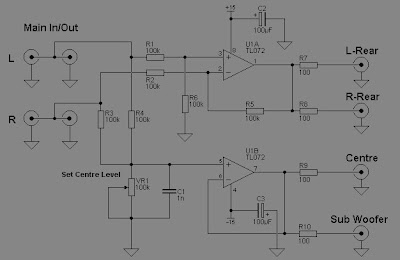Rangkain Surround Berbasis Op-Amp
Although there have been similar circuits published over the years, this is a little different in a few areas. I wanted to avoid having any active electronics in the main Left and Right channels, since this eliminates any possibility of sound degradation due to the introduction of the opamps. The input impedance of 50k will not pose a problem for any preamp (including valve types), and the main signal is simply in parallel with the additional circuitry.
No volume control has been included, since you already have one in the preamp. It would just become another component to fiddle with, and since it would be rarely used, would probably become noisy over time.
Although there have been similar circuits published over the years, this is a little different in a few areas. I wanted to avoid having any active electronics in the main Left and Right channels, since this eliminates any possibility of sound degradation due to the introduction of the opamps. The input impedance of 50k will not pose a problem for any preamp (including valve types), and the main signal is simply in parallel with the additional circuitry.
No volume control has been included, since you already have one in the preamp. It would just become another component to fiddle with, and since it would be rarely used, would probably become noisy over time.

Skema Rangkain Surround Berbasis Op-Amp
Opamp U1A is connected as a subtracting amplifier. Should the same signal be applied to both inputs, the output is zero. As a result, it will remove all common information from the stereo signal, and reproduce only the difference signal - in exactly the same way as the original Hafler design.
U1B is a simple summing amplifier, and the output contains all the information from both the left and right channels. A possibility that springs to mind is that we could then subtract the difference information from this output, so that only material that is absolutely common to both channels would be reproduced. Would this improve the performance to the extent that the extra circuitry is warranted? I tend to doubt it, but will look into this further.
U1B is a simple summing amplifier, and the output contains all the information from both the left and right channels. A possibility that springs to mind is that we could then subtract the difference information from this output, so that only material that is absolutely common to both channels would be reproduced. Would this improve the performance to the extent that the extra circuitry is warranted? I tend to doubt it, but will look into this further.
No comments:
Post a Comment